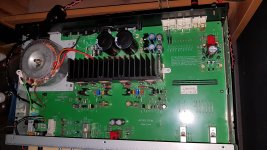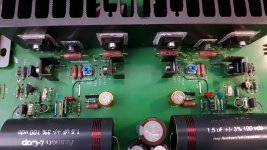Hi Ginetto, A more powerful amp will definitely give you more headroom and power reserve.
But what level are you normally really listening to music on? If you are trying to rip the paint off the walls, force the neighbors to move away or using the amp as PA for a heavy metal band - you'd better go for a high power digital amp.
You are right about the (now) historical drive for efficient speakers. Horns with Lowther, Fostex, Coral, etc.
I run my own floor standing dual internal horn design Angelhorns which have an efficiency of about 96dB and even the 8W Hiraga can make the house shake and blow the fur off the cat.
So the 50W RA-820 (or RA-931) only ever get their volume dial near or over the 12'o'clock position when nobody else is in the house - and I am safely outside in the garden doing a jolly gavort in the rain. 🙂umbrella:This is the UK, remember).
But I also have a pair of 89dB Snell J-II bass reflex speakers which I use as a reference, mainly because I have had them since the early 80'ies and know them so well.
An RA-820 still has plenty of power for the Snells - and the Rotel upgrades are very clearly audible.
The main reason that the 991 is more difficult to upgrade is that it is so high rail voltage and has a double differential topology design, whereas the 820 is a more classical single LTP/VAS amp.
Maybe Paulus has other views on this?
Best,
Per
Dear Mr Per, thank you very much for the kind and very helpful advice.
Lately i have been exposed at a friend's home to high efficiency system built around a pair of Tannoy dual concentric 15" drivers
And the 50x2 W amplifier was using just few watts
This experience has convinced me that high efficiency can reproduce more easily the live effect
About more complex design i was trivially thinking ... the more parts the more variables.
I have promised myself not to exaggerate with the amp power even if i understand the reasons of selecting a big unit with an ample power reserve.
Thanks a lot again.
Kind regards, gino
Maybe Paulus has other views on this?
I couldn't agree more with you Per...
@ginetto61; Take your trusted Rotel as your benchmark amp to drive the loudspeakers you're looking for and most important take your time with this search. Be certain that your Rotel is in optimum condition before you listen to different loudspeakers. I'm certain you'll find what you wish for in the end.
@tvrgeek; i read that post and also the one before (there 2 about quasimodo rigs) but that is out of my league.
Both of my RB-991's sound better then new but i get your point 😉 still, there are some things left that could be better 😀
Hi ! thanks a lot for the very kind and valuable advice.I couldn't agree more with you Per...
@ginetto61; Take your trusted Rotel as your benchmark amp to drive the loudspeakers you're looking for and most important take your time with this search. Be certain that your Rotel is in optimum condition before you listen to different loudspeakers. I'm certain you'll find what you wish for in the end ...
There is an old saying ... power corrupts. And someone applies it also to audio amps.
Personally i think they are wrong because high power but also very good sounding amps do exist.
Instead my doubts are more about design complexity. Is it really needed ?
If i am not wrong most of the distortion is cancelled by using feedback.
Moreover with very few gain stages a high gain can be achieved.
I am always impressed by those modding projects that actually take out parts, simplify the designs and improve the sound.
Just a very quick example ... i see for instance a small power bjt driving a medium power bjt ... why not using a darlington medium power bjt from the start ? i see only advantages
(I am going OT ... i will ask in another thread dealing with darlington because these devices interest me a lot indeed).
at the same way i like the Sanken solution for output stages ... more high power bjts on the same chip .. i find it very elegant.
And i understand they also sound really good ?
I end saying that i would expect to see the best parts available in the market used in a very high end unit.
Thanks a lot again,
gino
Last edited:
Hi
I have a Rotel 931 and I am in the beginning of moding.
For now I have removed all the unnecessary cables and pins, a new rectifier, new electrolytic capacitors everywhere. i also changed all resistors. I replaced the power busbars with hard core cables.
I i measured all 2sa1016 transistors and sorted them by hfe.
R625-628 was 220ohms now they are 100ohms.
The sound is very clean and detailed.
I wonder for low pas RC-filter in input stages or PARAMETRIC STABILIZER on 30-32V.
What do you mean for this idea?
I have a Rotel 931 and I am in the beginning of moding.
For now I have removed all the unnecessary cables and pins, a new rectifier, new electrolytic capacitors everywhere. i also changed all resistors. I replaced the power busbars with hard core cables.
I i measured all 2sa1016 transistors and sorted them by hfe.
R625-628 was 220ohms now they are 100ohms.
The sound is very clean and detailed.
I wonder for low pas RC-filter in input stages or PARAMETRIC STABILIZER on 30-32V.
What do you mean for this idea?
Attachments
Hi,
Well done, that is a good looking 931 ! A few questions: Why was only three of the four output emitter power resistors changed? Why did you change the driver emitter resistors from 220 to 100 ohm (it will probably work fine..but is this why you now need heat sink fins on the driver trannies)?
For constructive suggestions, I would dc couple the preamp to the power section (if the new red fancy discrete opamp's offset allows that). Then, I would put in CM1 current mirrors in place of R605/6 and my VAS3 drop-in modules for the 2SC1941 VAS transistors. i would also remove Rotel's heavy lag loading (C607/R623) and increase the NFB capacitor C605 to at least 220uF. The resulting audible improvements are astonishing...
I used to advocate for input stage filters, but found that if you have actually paired the LTP input trannies perfectly (within less than 1 hFE difference), the power stage PSRR shoots up and does the job perfectly, rendering these filters unneccesary.
Hope this helps you.
Best,
Per
Well done, that is a good looking 931 ! A few questions: Why was only three of the four output emitter power resistors changed? Why did you change the driver emitter resistors from 220 to 100 ohm (it will probably work fine..but is this why you now need heat sink fins on the driver trannies)?
For constructive suggestions, I would dc couple the preamp to the power section (if the new red fancy discrete opamp's offset allows that). Then, I would put in CM1 current mirrors in place of R605/6 and my VAS3 drop-in modules for the 2SC1941 VAS transistors. i would also remove Rotel's heavy lag loading (C607/R623) and increase the NFB capacitor C605 to at least 220uF. The resulting audible improvements are astonishing...
I used to advocate for input stage filters, but found that if you have actually paired the LTP input trannies perfectly (within less than 1 hFE difference), the power stage PSRR shoots up and does the job perfectly, rendering these filters unneccesary.
Hope this helps you.
Best,
Per
Hi Per,
thanks for ideas 🙂
1. "Why was only three of the four output emitter power resistors changed? "
i had changed all 4 resistors, but i had a smoke effect and one of them cracked. 🙁 Now i waiting for delivery of new ones.
2. "Why did you change the driver emitter resistors from 220 to 100 ohm (it will probably work fine..but is this why you now need heat sink fins on the driver trannies)?"
Sound after this mod is more fuller. The transistors are slightly warm, not hot.
3. "For constructive suggestions, I would dc couple the preamp to the power section (if the new red fancy discrete opamp's offset allows that)."
This Burson V5 opamps have ofset 10 and 20mV, that is not adjustable. 🙁
4. "Then, I would put in CM1 current mirrors in place of R605/6 and my VAS3 drop-in modules for the 2SC1941 VAS transistors."
I'm seriously thinking about this upgrade, what are the benefits of it?
5. i would also remove Rotel's heavy lag loading (C607/R623)
today I removed R623-4, but I was worried about oscillations and I haven't removed C607-8 yet. The effect is more sound density and much more bass. It even seems to me that the high have dropped a bit as a level.
I had put a multiturn trimmer Vishay for the bias adjustment, but the dynamics decreased and the sound became thinner. I return original trimmer and sound became more fuller.
6. increase the NFB capacitor C605 to at least 220uF. The resulting audible improvements are astonishing...
now i use bipolar 100uf Audio Note Kaisei
7. I used to advocate for input stage filters, but found that if you have actually paired the LTP input trannies perfectly (within less than 1 hFE difference), the power stage PSRR shoots up and does the job perfectly, rendering these filters unneccesary.
My 8 transistors 2SA1016 have hFE: 291, 296, 298, 305, 308, 308, 313, 375
I think to use dual 2SA1240 without changing the board.
Ihave for replasment 150W Sanken 2SA1294 and 2SC3263 for power transistors.
thanks for ideas 🙂
1. "Why was only three of the four output emitter power resistors changed? "
i had changed all 4 resistors, but i had a smoke effect and one of them cracked. 🙁 Now i waiting for delivery of new ones.
2. "Why did you change the driver emitter resistors from 220 to 100 ohm (it will probably work fine..but is this why you now need heat sink fins on the driver trannies)?"
Sound after this mod is more fuller. The transistors are slightly warm, not hot.
3. "For constructive suggestions, I would dc couple the preamp to the power section (if the new red fancy discrete opamp's offset allows that)."
This Burson V5 opamps have ofset 10 and 20mV, that is not adjustable. 🙁
4. "Then, I would put in CM1 current mirrors in place of R605/6 and my VAS3 drop-in modules for the 2SC1941 VAS transistors."
I'm seriously thinking about this upgrade, what are the benefits of it?
5. i would also remove Rotel's heavy lag loading (C607/R623)
today I removed R623-4, but I was worried about oscillations and I haven't removed C607-8 yet. The effect is more sound density and much more bass. It even seems to me that the high have dropped a bit as a level.
I had put a multiturn trimmer Vishay for the bias adjustment, but the dynamics decreased and the sound became thinner. I return original trimmer and sound became more fuller.
6. increase the NFB capacitor C605 to at least 220uF. The resulting audible improvements are astonishing...
now i use bipolar 100uf Audio Note Kaisei
7. I used to advocate for input stage filters, but found that if you have actually paired the LTP input trannies perfectly (within less than 1 hFE difference), the power stage PSRR shoots up and does the job perfectly, rendering these filters unneccesary.
My 8 transistors 2SA1016 have hFE: 291, 296, 298, 305, 308, 308, 313, 375
I think to use dual 2SA1240 without changing the board.
Ihave for replasment 150W Sanken 2SA1294 and 2SC3263 for power transistors.
Last edited:
Actually, the 2sa1240 dropped out due to large hfe differences.
If i have to combine my transistors which will you suggest for pairs.
If two channels have different xfe transistors is it a problem?
If i have to combine my transistors which will you suggest for pairs.
If two channels have different xfe transistors is it a problem?
Hi,
I don't like the sound of smoke and cracked emitter resistors. The mains secondary fuses should have blown before these power resistors. You need to measure the B-E and B-C diode drops in all the output power trannies, one may be faulty. The Sanken replacements are excellent, but if you haven't already done so please find out what is/was wrong before putting them in.
LTP hFE differences will show up as increased output offset. If you should decide to get the CM1 mirrors from me, I will offer to enclose (attached) pairs of precisely matched KSA992 with them if you wish.
4. "Then, I would put in CM1 current mirrors in place of R605/6 and my VAS3 drop-in modules for the 2SC1941 VAS transistors."
I'm seriously thinking about this upgrade, what are the benefits of it?
Well, if you don't believe my thread results, please read Cabirio's from post #183 and on.
5. i would also remove Rotel's heavy lag loading (C607/R623)
today I removed R623-4, but I was worried about oscillations and I haven't removed C607-8 yet. The effect is more sound density and much more bass. It even seems to me that the high have dropped a bit as a level.
I had put a multiturn trimmer Vishay for the bias adjustment, but the dynamics decreased and the sound became thinner. I return original trimmer and sound became more fuller.
Again, Cabirio discusses this in detail in his Spice simulations - while I actually did it and measured the improvements. No oscillations - if you employ the VAS3 with its onboard Miller compensation.
I must admit that I can't quite follow your impressions of a "fuller" sound, and of course your ears are the ultimate boss in all this, but I can tell you that the upgraded Rotel's SPL is linear as a whistle, so there are no measurable low or high frequency level changes.
Hope this helps you...
Best,
Per
I don't like the sound of smoke and cracked emitter resistors. The mains secondary fuses should have blown before these power resistors. You need to measure the B-E and B-C diode drops in all the output power trannies, one may be faulty. The Sanken replacements are excellent, but if you haven't already done so please find out what is/was wrong before putting them in.
LTP hFE differences will show up as increased output offset. If you should decide to get the CM1 mirrors from me, I will offer to enclose (attached) pairs of precisely matched KSA992 with them if you wish.
4. "Then, I would put in CM1 current mirrors in place of R605/6 and my VAS3 drop-in modules for the 2SC1941 VAS transistors."
I'm seriously thinking about this upgrade, what are the benefits of it?
Well, if you don't believe my thread results, please read Cabirio's from post #183 and on.
5. i would also remove Rotel's heavy lag loading (C607/R623)
today I removed R623-4, but I was worried about oscillations and I haven't removed C607-8 yet. The effect is more sound density and much more bass. It even seems to me that the high have dropped a bit as a level.
I had put a multiturn trimmer Vishay for the bias adjustment, but the dynamics decreased and the sound became thinner. I return original trimmer and sound became more fuller.
Again, Cabirio discusses this in detail in his Spice simulations - while I actually did it and measured the improvements. No oscillations - if you employ the VAS3 with its onboard Miller compensation.
I must admit that I can't quite follow your impressions of a "fuller" sound, and of course your ears are the ultimate boss in all this, but I can tell you that the upgraded Rotel's SPL is linear as a whistle, so there are no measurable low or high frequency level changes.
Hope this helps you...
Best,
Per
i tested some resistors with long legs and the amplifier oscillates. the two 5a fuses and one diode in the rectifier burned out.
I measured all the transitions and they are the same for both channels.
For now, 6 days, works fine.
I have 44 and 49mV DC offset in output.
can i remove 330pf now before i put your modules VAS3?
(I will send the mesage)
More fuller sound - with more bass, midbass, with more energy.
I measured all the transitions and they are the same for both channels.
For now, 6 days, works fine.
I have 44 and 49mV DC offset in output.
can i remove 330pf now before i put your modules VAS3?
(I will send the mesage)
More fuller sound - with more bass, midbass, with more energy.
Well, any gorgeous resister with long legs used to make me oscillate 😛, unfortunately some of the the diodes in my ageing rectifier has starting to burn out 🙁
Ok, on a serious note, no please do not remove stability caps until you have put in a Miller cap.
Best,
Per
Ok, on a serious note, no please do not remove stability caps until you have put in a Miller cap.
Best,
Per
Sorry for the amateur question, but what do you mean by Miller capacitor?
OK 330p and 150p stays there
OK 330p and 150p stays there
Last edited:
Hi may i ask in which position ? thanksi tested some resistors with long legs and the amplifier oscillates ...
A Miller capacitor is a small (100pF or less) cap placed between the collector and base of the VAS transistor (Q611/12). It creates a dominant pole compensation which starts to take effect at higher frequencies by reducing the open loop gain of the amp, thereby avoiding HF oscillations and ensuring stability. It also reduces distortion and improves linearity, etc.
You will find that Rotel has used these caps on earlier models and in the RA-931 there are actually two drilled holes, pads and tracks on the pcb next to the 2SC1941's for a Miller cap, so it is very easy to pop 100pF / 100V caps in.
Why Rotel (or Stan Curtis) decided to switch to the heavy lag loading (C607 and R623) of the VAS for stability is not clear - except that this creates the smooth / warm Rotel "Sound" which became Rotel's trademark and led to a very high sales success.
I used to like it - until I attended a comparison test with a Class A amp.Then it suddenly got obvious how much openness and detail in the music gets smoothed (or smothered, rather) out by this type of compensation.
So I then soon built my first 8W Hiraga "Le Monstre" and sold my Rotel. It wasn't until the start of this long diyAudio thread that I realised that it is possible to upgrade a Rotel to almost rival the Class A amp performance - without its overheating issues, etc.
And you end up with a nice, professional looking and fantastically sounding amp - at a budget price. What's not to like?🙂
Per
You will find that Rotel has used these caps on earlier models and in the RA-931 there are actually two drilled holes, pads and tracks on the pcb next to the 2SC1941's for a Miller cap, so it is very easy to pop 100pF / 100V caps in.
Why Rotel (or Stan Curtis) decided to switch to the heavy lag loading (C607 and R623) of the VAS for stability is not clear - except that this creates the smooth / warm Rotel "Sound" which became Rotel's trademark and led to a very high sales success.
I used to like it - until I attended a comparison test with a Class A amp.Then it suddenly got obvious how much openness and detail in the music gets smoothed (or smothered, rather) out by this type of compensation.
So I then soon built my first 8W Hiraga "Le Monstre" and sold my Rotel. It wasn't until the start of this long diyAudio thread that I realised that it is possible to upgrade a Rotel to almost rival the Class A amp performance - without its overheating issues, etc.
And you end up with a nice, professional looking and fantastically sounding amp - at a budget price. What's not to like?🙂
Per
Merry Christmas!
Hello everyone,
Firstly, please allow me to wish all those who follow this thread a very Merry Christmas and a (hopefully) Happy New Year.
What originally started as a silly wager has now run for over 4 years and by now almost 122,000 diyAudio'ers has viewed it.
So, there must have been something of interest on the thread and I plan to continue as long as new issues pop up.
All the best,
Per
Hello everyone,
Firstly, please allow me to wish all those who follow this thread a very Merry Christmas and a (hopefully) Happy New Year.

What originally started as a silly wager has now run for over 4 years and by now almost 122,000 diyAudio'ers has viewed it.
So, there must have been something of interest on the thread and I plan to continue as long as new issues pop up.

All the best,
Per
Per
Thank you for the valuable information and guidance.🙂🙂🙂
Have a good Xmas and new year of hope.

Thank you for the valuable information and guidance.🙂🙂🙂
Have a good Xmas and new year of hope.


Hello again. Here are some pictures from my Rotel.
I'm not done with the VAS settings yet. Without 330pf the right channel is not stable.
I'm not done with the VAS settings yet. Without 330pf the right channel is not stable.
Attachments
-
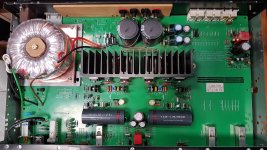 20210129_170603.jpg989.6 KB · Views: 492
20210129_170603.jpg989.6 KB · Views: 492 -
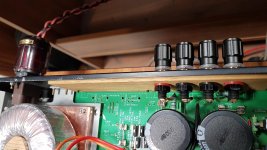 20210129_170635.jpg796.7 KB · Views: 482
20210129_170635.jpg796.7 KB · Views: 482 -
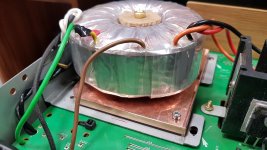 20210129_170724.jpg737 KB · Views: 456
20210129_170724.jpg737 KB · Views: 456 -
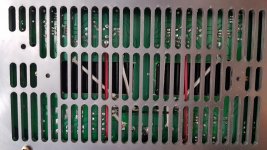 20210129_171013.jpg777 KB · Views: 213
20210129_171013.jpg777 KB · Views: 213 -
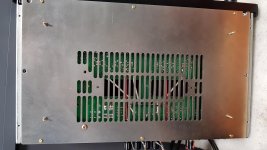 20210129_171003.jpg723.5 KB · Views: 370
20210129_171003.jpg723.5 KB · Views: 370 -
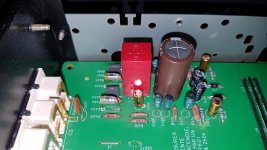 20210129_170900.jpg674.4 KB · Views: 431
20210129_170900.jpg674.4 KB · Views: 431 -
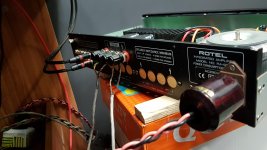 20210114_150754.jpg702.6 KB · Views: 193
20210114_150754.jpg702.6 KB · Views: 193 -
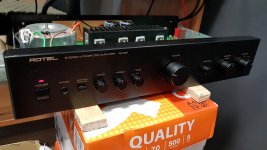 20210114_150447.jpg684.5 KB · Views: 228
20210114_150447.jpg684.5 KB · Views: 228
Last edited:
i'm thinking of removing C607-330pf. To replace C609-150pf with 33 or 27pf. I will also put a Miller capacitor 68 or 100pf on VAS.
What do you think are the appropriate values?
I have already removed P623-33k2 with good sound result.
What do you think are the appropriate values?
I have already removed P623-33k2 with good sound result.
Hi,
First, I think that you have done an impressive amount of nice work on the 931!
Installing the Miller caps will completely take over the stability of the amp from the 330pF load, decrease distortion and increase linearity, etc.
But it will take away the "nice, round" Rotel sound for a much more analytical, punchy sound (also called HiFi). Some love it, some don't.
In my experience, 68pF PS Millers will do the trick - and if you eventually decide to use my VAS3 modules instead of the 2SC1941's the modules include an integrated additional 33pF Miller which will further ensure stability.
The modules also include a 27pF VAS load so you will eventually be able to remove the 150pF's.
But until then I would leave the 150pF's in place.
Best,
Per
First, I think that you have done an impressive amount of nice work on the 931!

Installing the Miller caps will completely take over the stability of the amp from the 330pF load, decrease distortion and increase linearity, etc.
But it will take away the "nice, round" Rotel sound for a much more analytical, punchy sound (also called HiFi). Some love it, some don't.
In my experience, 68pF PS Millers will do the trick - and if you eventually decide to use my VAS3 modules instead of the 2SC1941's the modules include an integrated additional 33pF Miller which will further ensure stability.
The modules also include a 27pF VAS load so you will eventually be able to remove the 150pF's.
But until then I would leave the 150pF's in place.
Best,
Per
I have made many changes and improvements to my Rotel. Unfortunately, he still lacked something to like me enough. I'm glad I left the installation of Per's modules for the end. Now I understand what I lost in the sound picture, In fact, I have not had one so far.
With the new modules, I have a tangible real stage and musical instruments and space.
What more does a person need 🙂
PS: I haven't removed C609 (610) -150pf yet and have Miller 65pF silver mica caps across the C-B of the VAS3.
With the new modules, I have a tangible real stage and musical instruments and space.
What more does a person need 🙂
PS: I haven't removed C609 (610) -150pf yet and have Miller 65pF silver mica caps across the C-B of the VAS3.
Attachments
- Home
- Amplifiers
- Solid State
- Improve a Rotel amp THD by 20dB!
